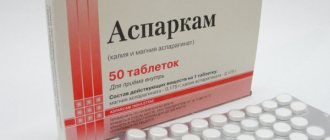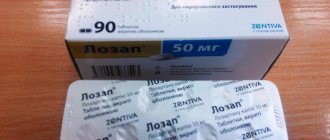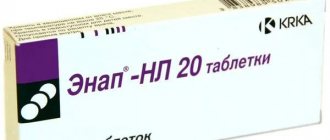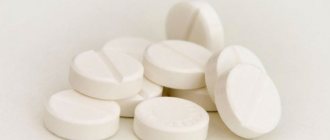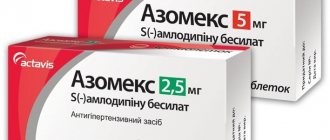Composition and release form
The main active ingredient is telmisartan. The drug is available in dosages of 20, 40 and 80 mg. The usual daily dose is 40 mg. If necessary, it can be increased to 80 mg. The maximum therapeutic effect develops after 4-8 weeks of therapy with Hypotel 80. Instructions for use recommend a single dose per day.
Auxiliary components: mannitol, Mg stearate, meglumine, Na hydroxide, crospovidone. The package contains 3 blisters of 10 tablets or 2, 4 or 6 blisters of 14 tablets. The drug is taken orally, regardless of food intake; the tablets are not intended for resorption under the tongue.
For hypertension, regular monitoring of blood pressure is necessary.
Instructions for use "Hipotel"
For the treatment of hypertension, a dose of 80 mg of telmisartan is used when the standard 40 mg is not effective and target blood pressure levels are not achieved (< 140/90 mmHg). To prevent cardiovascular complications, Hipotel is used at a dose of 80 mg per day. The tablets are taken once a day, regardless of meals. For the first month, it is recommended to take it on an empty stomach in the morning, without skipping it.
Features of use during pregnancy or breastfeeding
The use of the medication is contraindicated during pregnancy.
During pregnancy, it is absolutely contraindicated to prescribe sartans, as they have a toxic effect on the development of the fetus. Potential adverse effects in neonates include cranial hypoplasia, anuria, hypotonia, renal failure, and death. You should stop taking Hypotel if pregnancy is confirmed. If the angiotensin 2 receptor antagonist cannot be stopped, then a sonographic examination (ultrasound) should be performed, and the mother should be informed about the possible risks. There is no information on the use of telmisartan during breastfeeding, but alternative treatment that has proven safety is preferred.
How is it used in children?
The drug is contraindicated for persons under 18 years of age, since there is no evidence base for the effective use of Hypotel in children. There are no direct indications for the use of sartans in children; for similar pathologies, drugs that are harmless to the development of the child are used. In laboratory conditions, it has been proven that the maximum concentration is achieved in the same way as in adults - within 6–8 hours from the time of taking the drug.
pharmachologic effect
Telmisartan inhibits angiotensin II-sensitive receptors and acts on the renin-angiotensin-aldosterone system:
- The liver produces angiotensinogen, a substance from the group of peptides, which, under the influence of the enzyme renin, is converted into angiotensin I.
- Renin is synthesized by the juxtaglomerular apparatus of the kidneys. The release of renin is promoted by activation of the sympathetic nervous system under the control of β1-adrenergic receptors.
- Their activation enhances the production of renin and leads to activation of the entire system.
- Other important stimuli for its production include a decrease in renal perfusion and a decrease in the volume of circulating fluid - hypovolemia.
Angiotensin I is converted to angiotensin II. This process occurs under the influence of the angiotensin-converting enzyme, ACE, contained in the endothelial cells of blood vessels.
RAAS
Angiotensin II acts on target organs. Both effects together lead to increased blood pressure:
- Stimulates receptors located in blood vessels and has a direct vasoconstrictor effect.
- Angiotensin acts on adrenal receptors and stimulates the secretion of aldosterone, which leads to sodium retention and increased potassium loss. In response to sodium retention, the amount of antidiuretic hormone increases, which in turn retains water in the body, leading to an increase in circulating fluid and an increase in blood pressure.
Telmisartan blocks receptors, as a result of which angiotensin II cannot realize its functions in target organs.
Who is it contraindicated for?
Contraindications for the use of Hypotel include:
- hypersensitivity to telmisartan and other components;
- pregnancy;
- liver dysfunction;
- blockage of the bile ducts;
- narrowing of the renal arteries;
- taking ACE inhibitors (Lisinopril, Ramipril).
The medicine is not prescribed to patients with liver disease.
You should not combine the use of Hipotela tablets with lithium preparations, potassium-sparing diuretics (Veroshpiron, Spironolactone), immunosuppressants, heparin, or non-steroidal anti-inflammatory drugs. Such combinations lead to an increase in the amount of potassium in the body and leads to paralysis, heart rhythm disturbances, which can result in cardiac arrest.
Indications for use
Hypotel tablets and its Russian analogues are used for:
- essential arterial hypertension;
- chronic form of heart failure;
- diabetic nephropathy and for its prevention;
- proteinuria;
- angiopathy.
The drug can also be taken to prevent the occurrence of heart and vascular diseases in patients with coronary heart disease, stroke and type II diabetes mellitus, as well as to reduce the risk of ventricular arrhythmias.
Taking the drug according to the instructions leads to a number of main positive effects:
- a decrease in pressure in the kidneys, a change in the input-electrolyte balance, a decrease in proteinuria have a complex protective effect on the kidneys;
- weakening of peripheral vascular resistance causes a decrease in blood pressure;
- protective effect on the heart and blood vessels.
Appearance of the package
Of all the drugs in the group, telmisartan is the most lipophilic, which allows the drug to penetrate into the deep layers of tissue and provide effective blockade of AT1 receptors throughout the body. The long half-life (more than 20 hours) also enhances effectiveness.
Side effects
Undesirable effects from taking Hypotel are associated with dysfunction of angiotensin II:
- Hypotension.
Hipotel and its analogues are capable of excessively reducing blood pressure. The risk group includes patients with hypovolemia, hyponatremia and dehydration. Concomitant use of diuretics increases the risk of hypotension. The risk is also higher in patients with left ventricular obstruction. To reduce the likelihood of an excessive drop in pressure, it is necessary to carefully select the dosage and regularly monitor the indicators.
- Hyperkalemia.
Taking Hypotel reduces the production of aldosterone and potassium retention in the body. Most often, this effect occurs with reduced renal function, especially in elderly patients.
- Kidney failure.
Possible in patients with bilateral renal stenosis as a result of a drop in renal pressure associated with other mechanisms.
- Teratogenic effect.
Drugs of this group cause fetal deformities and the impossibility of normal organogenesis. Angiotensin II is an important factor in angiogenesis - the formation of blood vessels; suppression of angiotensin II in the fetus disrupts their development. Therefore, it is extremely dangerous to use such drugs during pregnancy.
In contrast to ACE inhibitors, the risk of dry cough and angioedema when taking Hypotel and its analogues, according to reviews from users, is minimal.
Side effects
In addition to the expected effects of telmisartan, unwanted side effects may also occur that require medical attention. In 90% of cases, side effects disappear as the body gets used to and adapts to the medication. Some effects require emergency medical attention. The attending physician should provide information about possible effects and prevent or reduce their impact. If any of the conditions listed in the table below occur while taking the tablets, consult your doctor.
| Organs of influence | Effect |
| Eyes | Visual impairment |
| CNS | Dizziness, headache, general weakness, lethargy, inability to concentrate |
| Heart | Rapid or irregular heartbeat, chest pain or discomfort |
| Skeleton | Pain, redness of the joints, numbness, tingling, cramps in the limbs |
| Gastrointestinal tract | Dyspeptic symptoms such as nausea, vomiting, heartburn, abdominal pain |
| Genitourinary system | Painful urination or changes in urinary frequency |
| Leather | Itching, rash, redness |
| Other | Weight gain in a short period of time |
Drug interactions
- Diuretics.
When telmisartan is co-administered with loop or thiazide diuretics, the risk of hypotension increases. Like other drugs that inhibit the renin-angiotensin-aldosterone system, telmisartan can cause hyperkalemia. The risk increases when taken together with potassium-sparing diuretics, ACE inhibitors, NSAIDs, and potassium supplements. If simultaneous use is necessary, it is necessary to adjust the dosage regimen, starting or continuing with small dosages and gradually increasing to the optimal one.
- Lithium.
When combining ACE inhibitors, telmisartan with lithium preparations, there are cases of increased lithium levels in the blood serum. If coadministration is necessary, serum lithium levels should be monitored regularly.
- NSAIDs.
Nonsteroidal anti-inflammatory drugs can reduce the hypotensive effect of telmisartan. In patients with impaired renal function, their combination can cause a deterioration in their function up to acute renal failure. Patients, especially the elderly, should maintain sufficient fluid intake and periodically check their kidney function.
The simultaneous use of telmisartan with hypotonic drugs of other groups mutually enhances their effect on the body.
Overdose: what to do?
A large dose of the drug causes discomfort in the heart area.
During an overdose of the drug, a sharp decrease in blood pressure, increased heart rate, headache, and dizziness are observed. The level of creatinine in the blood serum increases, which indicates the development of acute renal failure. The condition directly depends on the time that has passed after taking the pills. In the hospital, the general condition of the patient is monitored. Monitor pulse, blood pressure, respiratory rate, as well as plasma electrolyte levels (sodium, potassium, calcium, chlorine), and creatinine concentrations. First aid consists of the following steps:
- Flushing the stomach with plenty of water.
- Use of sorbents - “Atoxil”, “White Coal”, “Enterosgel”.
- Drink plenty of warm, slightly salted water.
Negative effects of angiotensin II on the body
In the body, blood pressure is regulated by two important systems: the sympathetic nervous system and the renin-angiotensin-aldosterone system. The sympathetic controls the work of the heart, the RAAS is responsible for the volume of circulating fluid. Their joint activity determines vascular tone and pressure indicators.
The effect of angiotensin II on the body
Angiotensin II has a number of different physiological effects and is one of the key links in the pathogenesis of various diseases, including arterial hypertension and kidney diseases accompanied by albuminuria:
- Inflammation.
Angiotensin II increases the secretion of inflammatory cytokines and promotes the formation of superoxides.
- Changes in kidney function.
Stimulates the production of aldosterone, which leads to changes in water-electrolyte balance and fluid retention. Angiotensin II, through direct vasoconstriction and enhancement of the sympathetic nervous system, alters renal hemodynamics and blood flow. This process leads to increased renal perfusion and increased renin secretion. This action does not allow the pressure to decrease.
- Total peripheral vascular resistance.
Angiotensin II directly causes constriction of the arteries, which leads to an even greater increase in blood pressure, and stimulates sympathetic vascular activity.
- Changing the structure of the cardiovascular system.
Angiotensin II causes an enlargement of the left ventricle of the heart and the vascular wall. Activation of angiotensin receptors stimulates the production of growth factors that contribute to an increase in heart size. Extracellular matrix proteins stimulate fibrosis of cardiac and vascular tissues.
Comparative characteristics of sartans and ACE inhibitors
Table of other drugs from the sartan group.
| Losartan Valsartan | Tablets with a short duration of action, require twice daily dosing |
| Irbesartan Candesartan | New generation drugs with a single dose per day |
Advantages of telmisartan over ACE inhibitors:
- ACE inhibitors prevent the transition of angiotensin I to angiotensin II, but this process does not stop completely;
- under the influence of enzymes such as chymase and chymotrypsin, partial conversion of angiotensin I occurs, and all the negative effects on the body are realized;
- This process, although significantly limited, may be sufficient for the development of diseases;
- Sartans block the receptors themselves that are affected by angiotensin II - angiotensin receptors of the first type, and prevent undesirable consequences.
Sartans and ACE inhibitors
The effect of the drug Hypotel on the body
Angiotensin II increases blood pressure and triggers a number of negative processes in the body, which ultimately leads to a reduction in the duration and quality of life. Sartans prevent these effects.
Telmisartan can be taken once a day, which is a significant advantage and allows you to avoid regular changes in blood pressure, including dangerous morning ones, which reduces the risk of stroke.
In addition to the main pharmacological action, sartans have a number of positive effects on the entire human body.
Protection against heart attack and stroke
Cardiovascular pathologies are the most common cause of death among the population. Telmisartan is a drug with proven effectiveness for the prevention of heart attack and stroke due to progressive vascular atherosclerosis.
Inflammation of cholesterol plaques underlies their pathogenesis. At the beginning of the disease, oxidative processes occur, then the inflammatory response is activated, and the lumen of the vessel narrows as a result of an increase in cholesterol plaque.
Atherosclerosis
Antagonists of angiotensin II receptors and hypotel in particular exhibit antiatherosclerotic effects by increasing the stability of cholesterol plaques. This effect is most pronounced for preventing the disease than in later stages.
Telmisartan effectively inhibits left ventricular hypertrophy, which is also an important factor in preventing heart attack.
Protection against diabetes
Telmisartan increases the sensitivity of cells to insulin, which helps prevent or cure type II diabetes, reduce the level of “bad” cholesterol and improve blood lipids. In terms of this effect, telmisartan is approximately 20 times more powerful than losartan, while losartan itself reduces the risk by 57%.
Also, its intake prevents the development of heart and vascular diseases associated with diabetes. Sartans affect the hormone leptin, thereby helping to fight excess weight.
The antifibrotic properties of the drug protect against kidney nephropathy in diabetes, inhibit the development of the disease and promote cure. Taking Hypotel for this purpose is acceptable even if blood pressure is initially normal. The combination with aspirin further increases the protective effect of the drug.
Protecting Muscles from Sarcopenia
Sarcopenia is a disease associated with a decrease in muscle mass with aging and is one of the causes of mortality in old age. In addition, the disease significantly reduces the quality of life and makes a person weak and helpless.
Among other negative effects of angiotensin is its ability to accelerate the progression of sarcopenia. Its blockade helps prevent muscle loss. Telmisartan (Hypotel) is most effective, but other drugs in the group also reduce muscle atrophy.
Sarcopenia in the elderly
Protecting the Brain from Alzheimer's Disease
Today, the disease is incurable and leads to the death of the patient after 5-7 years. The development of the disease is accompanied by a decrease in memory, thinking abilities, and senile dementia. One of the reasons for its onset is the influence of angiotensin II. Sartans are promising drugs for the prevention of Alzheimer's disease.
In the near future, studies are planned on their effectiveness in the treatment of the disease and other mental disorders. Sartans have a protective effect even in small dosages.
Protection against prostate adenoma and uterine fibroids
Male prostate adenoma and female uterine fibroids are a real epidemic in modern society. The antifibrotic properties of sartans stop the growth of tumor formations and the processes of hyperplasia of prostate tissue. By blocking angiotensin, they reduce the production of hormones, thereby slowing down the growth of uterine fibroids in women.
Slow down the aging of the body
According to the results of experiments on mice, blockade of genes responsible for the sensitivity of receptors to angiotensin increases life expectancy not only due to the protection of the heart and blood vessels, but also as a result of a general decrease in the rate of aging.
Mice with a congenital deficiency of angiotensin receptors live longer than normal by about 26%. In addition, the main causes of death in mice are cancer, infectious diseases and poor kidney function. This once again suggests that sartans are capable of prolonging human life by slowing down the aging process and the rate of development of various pathologies.
Additional research is needed to confirm these speculations. However, a large number of studies have already been accumulated, giving the right to believe that the RAAS system and the regulation of angiotensin have a significant impact on the aging process of the body.
Sartans can slow down aging
Hypotel
About the drug:
Telmisartan is a specific and effective angiotensin II receptor antagonist (type AT1).
Indications and dosage:
- Treatment of essential hypertension in adults.
- Prevention of cardiovascular disease in patients with: manifest atherothrombotic cardiovascular disease (CHD, stroke, or history of peripheral arterial disease) or type II diabetes mellitus with documented end-organ damage.
Treatment of essential hypertension. The usual effective dose is 40 mg/day. A daily dose of 20 mg may be sufficient for some patients. In cases where the desired effect is not achieved, the dose of telmisartan can be increased to 80 mg 1 time per day. Alternatively, telmisartan can be given in combination with thiazide diuretics, such as hydrochlorothiazide, which has demonstrated additional blood pressure reduction when used with telmisartan. When considering increasing the dose, it must be taken into account that the maximum antihypertensive effect is generally achieved after 4-8 weeks from the start of treatment.
Prevention of cardiovascular diseases. The recommended dose is 80 mg 1 time per day. The effectiveness of telmisartan in doses less than 80 mg in preventing cardiovascular disease is unknown.
At the beginning of treatment with telmisartan in order to prevent cardiovascular diseases, it is recommended to monitor blood pressure and, if necessary, adjust the dose of drugs that lower blood pressure.
Hypotel can be taken with or without food.
Special groups of patients.
Renal dysfunction. For patients with mild to moderate renal failure, no dose adjustment is required. Experience in treating patients with renal failure or patients on hemodialysis is limited. It is recommended that such patients begin treatment with a low dose of 20 mg.
Liver dysfunction. For patients with mild or moderate liver dysfunction, the daily dose should not exceed 40 mg 1 time per day (see SPECIAL INSTRUCTIONS).
Elderly patients. No dose adjustment is required for elderly patients.
Overdose:
There is insufficient information about overdose in humans.
Symptoms. Significant manifestations of telmisartan overdose were arterial hypotension and tachycardia; bradycardia, dizziness, increased plasma creatinine concentrations and acute renal failure have also been reported.
Therapy. Telmisartan is not eliminated by hemodialysis.
Patients should be closely monitored and receive symptomatic and supportive therapy. Therapy depends on the time elapsed after taking the drug and the severity of symptoms. Recommended measures include inducing vomiting and/or gastric lavage. When treating an overdose, activated carbon can be used. Plasma electrolyte and creatinine levels should be checked frequently. If arterial hypotension occurs, the patient should be placed on his back and assistance should be provided to quickly replenish the volume of fluid and salt in the body.
Side effects:
In each group, side effects are presented in order of decreasing severity.
- Infections and infestations: upper respiratory tract infections, including pharyngitis and sinusitis, urinary tract infections, including cystitis, sepsis, including fatal ones.
- From the blood and lymphatic system: anemia, thrombocytopenia, eosinophilia.
- From the immune system: hypersensitivity, anaphylactic reactions.
- Metabolism and nutritional disorders: hyperkalemia, hypoglycemia (in diabetic patients).
- Mental disorders: depression, insomnia, anxiety.
- From the nervous system: syncope.
- From the organ of vision: visual impairment.
- From the vestibular apparatus: vertigo.
- Cardiac disorders: bradycardia, tachycardia.
- Vascular disorders: arterial hypotension, orthostatic hypotension.
- From the respiratory system, chest and mediastinum: shortness of breath, cough, interstitial lung disease.
- From the digestive system: abdominal pain, diarrhea, dyspepsia, flatulence, vomiting, discomfort in the stomach, dry mouth.
- Hepatobiliary system disorders: liver dysfunction/liver disorders.
- From the skin and subcutaneous tissue: increased sweating, itching, rashes, erythema, angioedema (including fatal), drug-induced dermatitis, toxic dermatitis, eczema, urticaria.
- From the musculoskeletal system and connective tissue: myalgia, back pain (eg sciatica), muscle cramps, arthralgia, pain in the extremities, pain in the tendon (symptoms similar to tendonitis).
- From the urinary system: impaired renal function, including acute renal failure.
- General disorders: chest pain, asthenia (weakness), flu-like symptoms.
- Laboratory data: increased creatinine in the blood, increased uric acid in the blood, increased liver enzymes, increased CPK levels in the blood, decreased hemoglobin.
Contraindications:
- Hypersensitivity to the components of the drug
- II and III trimester of pregnancy
- Obstructive biliary disorders
- Severe liver dysfunction
In the case of rare hereditary diseases, due to which there may be incompatibility with the excipient of the drug, taking Hipotel is contraindicated.
Interaction with other drugs and alcohol:
Like other drugs that inhibit the renin-angiotensin system, telmisartan can cause hyperkalemia. The risk may increase when treated in combination with other drugs that can also provoke hyperkalemia (salt substitutes containing potassium, potassium-sparing diuretics, ACE inhibitors, angiotensin II receptor antagonists, NSAIDs (including selective COX-2 inhibitors), heparin, immunosuppressants (cyclosporine or tacrolimus) and trimethoprim).
The occurrence of hyperkalemia depends on the relevant risk factors. The risk increases when using the above therapeutic combinations. The risk is especially high when combined with potassium-sparing diuretics and in combination with salt substitutes containing potassium. Combination with ACE inhibitors or NSAIDs is less risky, provided strict adherence to precautions during use.
Concomitant use is not recommended
Potassium-sparing diuretics or potassium supplements. Angiotensin II receptor antagonists such as telmisartan mitigate diuretic-induced potassium loss. Potassium-sparing diuretics, such as spironolactone, eplerenone, triamterene or amiloride, potassium supplements, or salt substitutes containing potassium may cause significant increases in plasma potassium concentrations. If concomitant use is indicated due to documented hypokalemia, the drugs should be administered with caution and frequent monitoring of plasma potassium levels.
Lithium. There are known cases of reversible increases in plasma lithium concentrations and toxicity when taking lithium concomitantly with ACE inhibitors and angiotensin II receptor antagonists, including telmisartan. If administration of this combination is considered necessary, closely monitor plasma lithium levels during concurrent use.
Concomitant use requires caution
NSAIDs. NSAIDs (i.e., acetylsalicylic acid in anti-inflammatory regimens, COX-2 inhibitors and non-selective NSAIDs) may reduce the antihypertensive effect of angiotensin II receptor antagonists.
In some patients with deteriorating renal function (eg, dehydrated patients or the elderly with deteriorating renal function), the combination of angiotensin II receptor antagonists and COX-inhibiting agents may lead to further deterioration of renal function, including possible acute renal failure, which is usually is reversible. Therefore, this combination should be prescribed with caution, especially in the elderly. Patients should be ensured adequate hydration; in addition, after starting combination therapy, and periodically thereafter, it is necessary to monitor renal function.
Diuretics (thiazide or loop diuretics). Previous treatment with high doses of diuretics such as furosemide (loop diuretic) and hydrochlorothiazide (thiazide diuretic) may lead to loss of blood volume and the risk of hypotension if treatment with telmisartan is started.
Should be taken into account during simultaneous use
Other antihypertensive drugs. The ability of telmisartan to lower blood pressure can be increased by concomitant use of other antihypertensive drugs.
Based on the pharmacological properties of baclofen and amifostine, it can be expected that these drugs can enhance the hypotensive effect of all antihypertensive drugs, including telmisartan. In addition, orthostatic hypotension can be exacerbated by alcohol, barbiturates, narcotics, and antidepressants.
Corticosteroids (systemic use). Reducing the severity of antihypertensive effect.
Composition and properties:
Telmisartan 40 mg / 80 mg
Release form:
- Pills.
Pharmachologic effect:
Telmisartan with very high affinity replaces angiotensin II at its binding sites on the AT1 subtype receptors responsible for the activity of angiotensin II. Telmisartan does not exhibit any partial agonist effect on the AT1 receptor. Telmisartan selectively binds the AT1 receptor. The bond is long lasting.
Telmisartan does not show affinity for other receptors, including AT2 and other less studied AT receptors. The functional role of these receptors is unknown, as is the effect of their possible “hyperstimulation” of angiotensin II, the level of which increases under the influence of telmisartan. Telmisartan reduces plasma aldosterone levels. Telmisartan does not inhibit renin in human plasma and does not block the ion channel. Telmisartan does not inhibit angiotensin-converting enzyme (kininase II) and also destroys bradykinin. Therefore, potentiation of bradykinin-associated side effects should not be expected.
In humans, telmisartan at a dose of 80 mg almost completely inhibits the increase in blood pressure caused by angiotensin II. The blocking effect lasts for 24 hours and remains noticeable for up to 48 hours.
Storage conditions:
In original packaging at a temperature not exceeding 25 °C.
general information
- Sales form:
on prescription
- Current issue:
Telmisartan
- Manufacturer:
Kusum Healthker Pvt. Ltd., India
